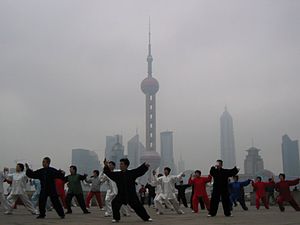
There are hundreds of different styles of Chinese martial arts, each with their own sets of techniques and ideas. The various movements in kung fu, most of which are imitations of the fighting styles of animals, are initiated from one to five basic foot positions: normal upright posture and the four stances called dragon, frog, horse riding, and snake.
The concept of martial arts styles appeared from around the Ming dynasty. Before the Ming period, martial skills were commonly differentiated mainly by their lineage.[1] There are common themes among these styles which allow them to be grouped according to generalized "families" (家; jiā), "fractions" (派; pài), "class" (门; mén), or "schools" (教; jiào) of martial art styles. There are styles that mimic movements from animals, or otherwise refer or allude to animals or mythical beings such as dragons, and others that gather inspiration from various Chinese philosophies or mythologies. Some deeply internal styles tend to focus strongly on practice relating to harnessing of qi energy, while some more-conspicuously external styles tend more to display skills and abilities in competition or exhibition.
The rich variety of styles has led to the creation of numerous classification schemes.[2][3] Geographical location such as regional affiliation is one well-known example. A particular Chinese martial arts style can be referred to as either a northern fist (北拳) or a southern fist (南拳) depending on its point of origin. Additional details such as province or city can further identify the particular style. Other classification schemes include the concept of external (外家拳) and internal. This criterion concerns the training focus of a particular style. Religious affiliation of the group that found the style can also be used as a classification. The three great religions of Taoism, Buddhism and Confucianism have associated martial arts styles. There are also many other criteria used to group Chinese martial arts; for example, imitative-styles (像形拳) and legendary styles; historical styles and family styles. Another more recent approach is to describe a style according to their combat focus.
- ^ Lorge, Peter (2012). Chinese Martial Arts From Antiquity to the Twenty-First Century. Cambridge: Cambridge University Press. ISBN 9780521878814.
- ^ Brian Kennedy and Elizabeth Guo (2005), Chinese Martial Arts Training Manuals: A Historical Survey, CA: North Atlantic Books, ISBN 1-55643-557-6
- ^ Fuo, Hsi Fen (郭希汾) (1920). 《中國體育史》 [Chinese China Sports History] (in Chinese). Shanghai: Commercial Press. ISBN 7-80569-179-7
© MMXXIII Rich X Search. We shall prevail. All rights reserved. Rich X Search
